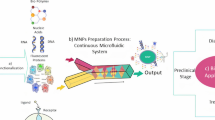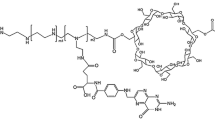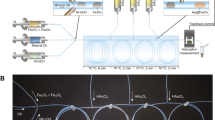Abstract
The work involves design and fabrication of a new microfluidic platform to synthesize palladium (Pd) nanoparticles coated with trimethyl chitosan (TMC), for biomedical applications. TMC-coated palladium nanoparticles (TMC/Pd NPs) were prepared in continuous mode, using the microfluidic reactor. Droplet-generation approach was adopted since it provides a high degree of control over mixing and reagent loading. However, one major limitation was the cumbersome recovery of the synthesized nanoparticles, which required laborious “off-chip” procedures like droplet separation and nanoparticle re-suspension. These issues were overcome using the continuous flow microfluidic system integrated with separation system, to enable rapid synthesis and retrieval of TMC/PdNPs using a single platform. The synthesized nanoparticles were spherical, having an average diameter of 35–40 nm. These TMC/Pd NPs are yet unexplored for biomedical applications. Thus, their biocompatibility and cellular uptake was assessed using 3-(4,5-dimethylthiazol-2-yl)-2,5-diphenyltetrazolium bromide (MTT) assay, confocal microscopy and binding kinetics assay (Ligand Tracer® Green), which indicated the suitability of the formulation for biomedical applications.






Similar content being viewed by others
Abbreviations
- TMC:
-
Trimethyl chitosan
- TMC/Pd NPs:
-
TMC-coated palladium nanoparticles
- NPs:
-
Nanoparticles
- DES:
-
Deep eutectic solvent
References
Arul Dhas N (1998) Sonochemical preparation and properties of nanostructured palladium metallic clusters. J Mater Chem 8(2):445–450
Abalde-Cela S, Taladriz-Blanco P, de Oliveira MG, Abell C (2018) Droplet microfluidics for the highly controlled synthesis of branched gold nanoparticles. Sci Rep 8(1):2440
Abate AR, Weitz DA (2011) Syringe-vacuum microfluidics: a portable technique to create monodisperse emulsions. Biomicrofluidics 5(1):014107
Anna SL, Bontoux N, Stone HA (2003) Formation of dispersions using “flow focusing” in microchannels. Appl Phys Lett 82(3):364–366
Ashraf MA, Umar Shafiq AM, Saeed MM (2015) Design of industrial gravity type separators for the hydrocarbons and heavy oil-water separations. Res J Chem Sci 5(9):72–75
Attar A, Altikatoglu Yapaoz M (2018) Biosynthesis of palladium nanoparticles using Diospyros kaki leaf extract and determination of antibacterial efficacy. Preparat Biochem Biotechnol 48(7):629–634
Azharuddin M, Zhu GH, Das D, Ozgur E, Uzun L, Turner AP, Patra HK (2019) A repertoire of biomedical applications of noble metal nanoparticles. Chem Commun 55(49):6964–6996
Azizi S, Shahri MM, Rahman HS, Rahim RA, Rasedee A, Mohamad R (2017) Green synthesis palladium nanoparticles mediated by white tea (Camellia sinensis) extract with antioxidant, antibacterial, and antiproliferative activities toward the human leukemia (MOLT-4) cell line. Int J Nanomed 12:8841
Bae S, Jung E, Yu T, Seo TS (2018) Investigation on the nucleation stage of palladium nanoparticles using a microfluidic droplet generator integrated with in situ sol–gel quencher. Small 14(48):1802851
Bangde PS, Jain R, Dandekar P (2016) Alternative approach to synthesize methylated chitosan using deep eutectic solvents, biocatalyst and “green” methylating agents. ACS Sustain Chem Eng 4(6):3552–3557
Bharathiraja S, Bui NQ, Manivasagan P, Moorthy MS, Mondal S, Seo H, Phuoc NT, Phan TTV, Kim H, Lee KD (2018) Multimodal tumor-homing chitosan oligosaccharide-coated biocompatible palladium nanoparticles for photo-based imaging and therapy. Sci Rep 8(1):500
Chekin F (2015) Sol–gel synthesis of palladium nanoparticles supported on reduced graphene oxide: an active electrocatalyst for hydrogen evolution reaction. Bull Mater Sci 38(4):887–893
Chen A, Ostrom C (2015) Palladium-based nanomaterials: synthesis and electrochemical applications. Chem Rev 115(21):11999–12044
Chen Y, Li J, Li Q, Shen Y, Ge Z, Zhang W, Chen S (2016) Enhanced water-solubility, antibacterial activity and biocompatibility upon introducing sulfobetaine and quaternary ammonium to chitosan. Carbohyd Polym 143:246–253
Christopher GF, Anna SL (2007) Microfluidic methods for generating continuous droplet streams. J Phys D Appl Phys 40(19):R319
Conde J, Doria G, Baptista P (2012) Noble metal nanoparticles applications in cancer. J Drug Deliv. https://doi.org/10.1155/2012/751075
Dehsari HS, Ribeiro AH, Ersöz B, Tremel W, Jakob G, Asadi K (2017) Effect of precursor concentration on size evolution of iron oxide nanoparticles. Cryst Eng Commun 19(44):6694–6702
Dendukuri D, Tsoi K, Hatton TA, Doyle PS (2005) Controlled synthesis of nonspherical microparticles using microfluidics. Langmuir 21(6):2113–2116
Dizaj SM, Lotfipour F, Barzegar-Jalali M, Zarrintan MH, Adibkia K (2014) Antimicrobial activity of the metals and metal oxide nanoparticles. Mater Sci Eng C 44:278–284
Dubois L, Andersson K, Asplund A, Björkelund H (2013) Evaluating real-time immunohistochemistry on multiple tissue samples, multiple targets and multiple antibody labeling methods. BMC Res Notes 6(1):542
Dumas A, Couvreur P (2015) Palladium: a future key player in the nanomedical field? Chem Sci 6(4):2153–2157
Encarnação JC, Schulte T, Achour A, Björkelund H, Andersson K (2018) Detecting ligand interactions in real time on living bacterial cells. Appl Microbiol Biotechnol 102(9):4193–4201
Finger PT, Berson A, Ng T, Szechter A (2002) Palladium-103 plaque radiotherapy for choroidal melanoma: an 11-year study. Int J Radi Oncol Biol Physics 54(5):1438–1445
Geschiere SD, Ziemecka I, van Steijn V, Koper GJ, Esch JH, Kreutzer MT (2012) Slow growth of the Rayleigh-Plateau instability in aqueous two phase systems. Biomicrofluidics 6(2):022007
Gharachorlou A, Detwiler MD, Nartova AV, Lei Y, Lu J, Elam JW, Delgass WN, Ribeiro FH, Zemlyanov DY (2014) Palladium nanoparticle formation on TiO2 (110) by thermal decomposition of palladium (II) hexafluoroacetylacetonate. ACS Appl Mater Interfaces 6(16):14702–14711
Glawdel T, Elbuken C, Ren CL (2012) Droplet formation in microfluidic T-junction generators operating in the transitional regime. II. Modeling. Phys Rev E 85(1):016323
Hao N, Nie Y, Zhang JX (2018) Microfluidic synthesis of functional inorganic micro-/nanoparticles and applications in biomedical engineering. Int Mater Rev 63(8):461–487
Iida M, Ohkawa S, Er H, Asaoka N, Yoshikawa H (2002) Formation of palladium (0) nanoparticles from a microemulsion system composed of bis (N-octylethylenediamine) palladium (II) chloride complex. Chem Lett 31(10):1050–1051
Iwai K, Erdem EY, Sochol RD, Cheng JC, Doyle FM, Pisano AP, Lin L (2013) Microdroplet-based synthesis and centrifuge-free retrieval of nanoparticles via a continuous flow micropost array railing system. In: 2013 Transducers and Eurosensors XXVII: The 17th International Conference on Solid-State Sensors, Actuators and Microsystems (TRANSDUCERS & EUROSENSORS XXVII), IEEE
Jahn A, Reiner JE, Vreeland WN, DeVoe DL, Locascio LE, Gaitan M (2008) Preparation of nanoparticles by continuous-flow microfluidics. J Nanopart Res 10(6):925–934
**tapattanakit A, Junyaprasert VB, Kissel T (2009) The role of mucoadhesion of trimethyl chitosan and PEGylated trimethyl chitosan nanocomplexes in insulin uptake. J Pharm Sci 98(12):4818–4830
Kang K-K, Lee B, Lee C-S (2019) Recent progress in the synthesis of inorganic particulate materials using microfluidics. J Taiwan Inst Chem Eng 98:2–19
Kim H-S, Seo YS, Kim K, Han JW, Park Y, Cho S (2016) Concentration effect of reducing agents on green synthesis of gold nanoparticles: size, morphology, and growth mechanism. Nanoscale Res Lett 11(1):230
Kim YH, Zhang L, Yu T, ** M, Qin D, **a Y (2013) Droplet-based microreactors for continuous production of palladium nanocrystals with controlled sizes and shapes. Small 9(20):3462–3467
Krishnan RA, Pant T, Sankaranarayan S, Stenberg J, Jain R, Dandekar P (2018) Protective nature of low molecular weight chitosan in a chitosan—Amphotericin B nanocomplex—a physicochemical study. Mater Sci Eng, C 93:472–482
Kulkarni AD, Patel HM, Surana SJ, Vanjari YH, Belgamwar VS, Pardeshi CV (2017) N, N, N-Trimethyl chitosan: an advanced polymer with myriad of opportunities in nanomedicine. Carbohyd Polym 157:875–902
Kumar MR, Muzzarelli RA, Muzzarelli C, Sashiwa H, Domb A (2004) Chitosan chemistry and pharmaceutical perspectives. Chem Rev 104(12):6017–6084
LaMer VK, Dinegar RH (1950) Theory, production and mechanism of formation of monodispersed hydrosols. J Am Chem Soc 72(11):4847–4854
Leso V, Iavicoli I (2018) Palladium nanoparticles: toxicological effects and potential implications for occupational risk assessment. Int J Mol Sci 19(2):503
Li J, Xu B, Liu G, Chen G, Zhang T, Zhang F, Li C (2016) Aqueous controllable synthesis of spindle-like palladium nanoparticles and their application for catalytic reduction of 4-nitrophenol. Progress Nat Sci 26(3):295–302
Li LL, Li X, Wang H (2017) Microfluidic synthesis of nanomaterials for biomedical applications. Small Methods 1(8):1700140
LogithKumar R, KeshavNarayan A, Dhivya S, Chawla A, Saravanan S, Selvamurugan N (2016) A review of chitosan and its derivatives in bone tissue engineering. Carbohyd Polym 151:172–188
Makgwane PR, Ray SS (2014) Synthesis of nanomaterials by continuous-flow microfluidics: a review. J Nanosci Nanotechnol 14(2):1338–1363
Mourya V, Inamdar NN (2009) Trimethyl chitosan and its applications in drug delivery. J Mater Sci Mater Med 20(5):1057
Muzzarelli R, Muzzarelli C (2005) Chitosan chemistry: relevance to the biomedical sciences. Polysaccharides I. Springer, Berlin, pp 151–209
Navaladian S, Viswanathan B, Varadarajan T, Viswanath R (2009) A rapid synthesis of oriented palladium nanoparticles by UV irradiation. Nanoscale Res Lett 4(2):181
Phan TTV, Huynh T-C, Manivasagan P, Mondal S, Oh J (2020) An up-to-date review on biomedical applications of palladium nanoparticles. Nanomaterials 10(1):66
Rai M, Ingle AP, Birla S, Yadav A, Santos CAD (2016) Strategic role of selected noble metal nanoparticles in medicine. Crit Rev Microbiol 42(5):696–719
Saldan I, Semenyuk Y, Marchuk I, Reshetnyak O (2015) Chemical synthesis and application of palladium nanoparticles. J Mater Sci 50(6):2337–2354
Seemann R, Brinkmann M, Pfohl T, Herminghaus S (2011) Droplet based microfluidics. Rep Prog Phys 75(1):016601
Sharada S, Suryawanshi PL, Kumar R, Gumfekar SP, Narsaiah TB, Sonawane SH (2016) Synthesis of palladium nanoparticles using continuous flow microreactor. Colloids Surf A 498:297–304
Singh A, Malek CK, Kulkarni SK (2010) Development in microreactor technology for nanoparticle synthesis. Int J Nanosci 9(01n02):93–112
Singh B, Lobo H, Shankarling G (2011) Selective N-alkylation of aromatic primary amines catalyzed by bio-catalyst or deep eutectic solvent. Catal Lett 141(1):178–182
Snyman D, Hamman JH, Kotze AF (2003) Evaluation of the mucoadhesive properties of N-trimethyl chitosan chloride. Drug Dev Ind Pharm 29(1):61–69
Song Y, Hormes J, Kumar CS (2008) Microfluidic synthesis of nanomaterials. Small 4(6):698–711
Song Y, Kumar CS, Hormes J (2004) Synthesis of palladium nanoparticles using a continuous flow polymeric micro reactor. J Nanosci Nanotechnol 4(7):788–793
Tang S, Chen M, Zheng N (2014) Sub-10-nm Pd Nanosheets with renal clearance for efficient near-infrared photothermal cancer therapy. Small 10(15):3139–3144
Tanthapanichakoon W, Aoki N, Matsuyama K, Mae K (2006) Design of mixing in microfluidic liquid slugs based on a new dimensionless number for precise reaction and mixing operations. Chem Eng Sci 61(13):4220–4232
Teh S-Y, Lin R, Hung L-H, Lee AP (2008) Droplet microfluidics. Lab Chip 8(2):198–220
Thanh NT, Maclean N, Mahiddine S (2014) Mechanisms of nucleation and growth of nanoparticles in solution. Chem Rev 114(15):7610–7630
Tian Z, Ge X, Wang Y, Xu J (2019) Nanoparticles and nanocomposites with microfluidic technology. Polymer-based multifunctional nanocomposites and their applications. Elsevier, Amsterdam, pp 1–33
Trachsel F, Günther A, Khan S, Jensen KF (2005) Measurement of residence time distribution in microfluidic systems. Chem Eng Sci 60(21):5729–5737
Valencia PM, Farokhzad OC, Karnik R, Langer R (2012) Microfluidic technologies for accelerating the clinical translation of nanoparticles. Nat Nanotechnol 7(10):623–629
Vlamidis Y, Voliani V (2018) Bringing again noble metal nanoparticles to the forefront of cancer therapy. Front Bioeng Biotechnol. https://doi.org/10.3389/fbioe.2018.00143
Wang F, Li C, Sun LD, Xu CH, Wang J, Yu JC, Yan CH (2012) Porous single-crystalline palladium nanoparticles with high catalytic activities. Angew Chem 124(20):4956–4960
Wu M, Long Z, **ao H, Dong C (2016) Recent research progress on preparation and application of N, N, N-trimethyl chitosan. Carbohyd Res 434:27–32
**ong Y, McLellan JM, Chen J, Yin Y, Li Z-Y, **a Y (2005) Kinetically controlled synthesis of triangular and hexagonal nanoplates of palladium and their SPR/SERS properties. J Am Chem Soc 127(48):17118–17127
Xu J, Li S, Tan J, Wang Y, Luo G (2006) Preparation of highly monodisperse droplet in a T-junction microfluidic device. AIChE J 52(9):3005–3010
Yin L, Ding J, He C, Cui L, Tang C, Yin C (2009) Drug permeability and mucoadhesion properties of thiolated trimethyl chitosan nanoparticles in oral insulin delivery. Biomaterials 30(29):5691–5700
Yuan P, Ding X, Yang YY, Xu QH (2018) Metal nanoparticles for diagnosis and therapy of bacterial infection. Adv Healthcare Mater 7(13):1701392
Zeilinger M, Pichler F, Nics L, Wadsak W, Spreitzer H, Hacker M, Mitterhauser M (2017) New approaches for the reliable in vitro assessment of binding affinity based on high-resolution real-time data acquisition of radioligand-receptor binding kinetics. EJNMMI Res 7(1):22
Zhang J, Zhu X, ** Y, Shan W, Huang Y (2014) Mechanism study of cellular uptake and tight junction opening mediated by goblet cell-specific trimethyl chitosan nanoparticles. Mol Pharm 11(5):1520–1532
Zhang L, Gu F, Chan J, Wang A, Langer R, Farokhzad O (2008) Nanoparticles in medicine: therapeutic applications and developments. Clin Pharmacol Ther 83(5):761–769
Zhang Z, Wang Z, He S, Wang C, ** M, Yin Y (2015) Redox reaction induced Ostwald ripening for size-and shape-focusing of palladium nanocrystals. Chem Sci 6(9):5197–5203
Zhao C-X, He L, Qiao SZ, Middelberg AP (2011) Nanoparticle synthesis in microreactors. Chem Eng Sci 66(7):1463–1479
Zhu P, Tang X, Wang L (2016) Droplet generation in co-flow microfluidic channels with vibration. Microfluid Nanofluid 20(3):47
Acknowledgements
We are thankful to Anomitra Dey and Tejal Pant for guiding us with the studies involving confocal microscopy and kinetic studies.
Funding
Authors gratefully acknowledge the support of the Department of Atomic Energy/ Institute of Chemical Technology (DAE/ICT), and Department of Biotechnology-RGCB, Govt. of India (6242- P111/RGCB/PMD/DBT/PDJN/2015) for funding. We are thankful to Ramanujan fellowship research grant (SR/S2/RJN-139/2011) and Ramalingaswami fellowship research grant (BT/RLF/Re-entry/51/2011) for financial support. We are also thankful to the Council of Scientific and Industrial Research (CSIR) for SRF fellowship. We confirm that the manuscript is the authors’ original work and the manuscript has not received prior publication and is not under consideration for publication elsewhere.
Author information
Authors and Affiliations
Contributions
All authors have contributed in writing the manuscript and have approved the final version of the manuscript. ‡ These authors contributed equally.
Corresponding authors
Ethics declarations
Conflict of interest
We confirm that all authors of the manuscript have no conflict of interests to declare.
Additional information
Publisher's Note
Springer Nature remains neutral with regard to jurisdictional claims in published maps and institutional affiliations.
Supplementary Information
Below is the link to the electronic supplementary material.
10404_2020_2410_MOESM1_ESM.docx
Supporting Information file includes procedure for TMC synthesis, Figure (S1) which depicts 1H NMR for chitosan and TMC, Figure (S2–5) individual TEM images for NPs synthesized in batch, slug, transition-slug and droplet micro reactor (at the scale of 200nm), Figure (S6) Individual Droplet microreactor integrated setup with decanter. (DOCX 5097 KB)
Rights and permissions
About this article
Cite this article
Gaikwad, G., Bangde, P., Rane, K. et al. Continuous production and separation of new biocompatible palladium nanoparticles using a droplet microreactor. Microfluid Nanofluid 25, 27 (2021). https://doi.org/10.1007/s10404-020-02410-x
Received:
Accepted:
Published:
DOI: https://doi.org/10.1007/s10404-020-02410-x




